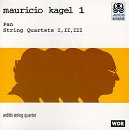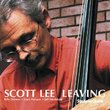| All Artists: Mauricio Kagel, Arditti String Quartet, Dietmar Wiesner Title: Kagel: Pan, String Quartets I, II, and III Members Wishing: 3 Total Copies: 0 Label: Disques Montaigne Release Date: 9/27/1993 Genre: Classical Style: Chamber Music Number of Discs: 1 SwapaCD Credits: 1 UPCs: 093046918828, 3298497890045, 329849789004 |
Search - Mauricio Kagel, Arditti String Quartet, Dietmar Wiesner :: Kagel: Pan, String Quartets I, II, and III
 | Mauricio Kagel, Arditti String Quartet, Dietmar Wiesner Kagel: Pan, String Quartets I, II, and III Genre: Classical
The Arditti Quartet gives ebullient performances of enfant terrible Mauricio Kagel's first three quartets--or is it two? Always rocking the boat, Kagel titles his first quartet(s) Streichquartett I/II (1965-67). Here he ex... more » |
Larger Image |
CD DetailsSynopsis
Amazon.com The Arditti Quartet gives ebullient performances of enfant terrible Mauricio Kagel's first three quartets--or is it two? Always rocking the boat, Kagel titles his first quartet(s) Streichquartett I/II (1965-67). Here he explores noise as the bridgework between I and II. The Ardittis separate the double quartet with a short piece (1985) for piccolo and string quartet. The third quartet (1987) fills half of the CD. Kagel embraces tradition through a plethora of radical musings. Rather than bludgeoning tradition with noise, he teases, exploits, pushes, and ultimately extends it, using the standard sound palette throughout. This exploration of structure, speech imitation, melody, harmony, and rhythm will reward many listenings. --Robert Reigle Similar CDs
|
CD ReviewsMarvellous performances. Francisco Yanez Calvino | Santiago de Compostela, GALIZA, Spain. | 06/05/2006 (5 out of 5 stars) "Another outstanding CD in the magnificent Arditti series in the French label Montaigne. This time they bring together the three quartets by the Argentinian composer Mauricio Kagel, joining too Pan, a brief piece for piccolo and strings. I have to say I really love Quartets number 1 and 2, from 1965-67, and I'm not so enthusiastic about Pan and the Third Quartet, much more tonal, melodic and conventional. I really prefer Kagel very radical time in the `60s, when he joined the central Europe vanguard music, with Stockhausen, Ligeti, Nono, Maderna, Lachenmann... one of my favourites music periods of all time. Those two early quartets are typical music from their time, full of dissonances, of col legno, tremolo, pizzicato, and all the complex techniques that was `classical' in that contemporary music. Very direct, it's music to hear carefully and paying full attention to the inner structure and sound effects. It demands very much on the listener, but it's good enough if try it. Outstanding recordings and what could I say about the performances, specially quartets 1 & 2, simply perfect!!! The typical pieces the Arditti Quartet play perfectly. A classics from our time. " Imagination and gesture at the center for Kagel scarecrow | Chicago, Illinois United States | 03/25/2005 (5 out of 5 stars) "What seems to guide to preserve Kagel's music is his imagination,his affinity for spectacle and performance art, theatre, and the interesting gestures that reside within that lifeworld. The early Sixties Quartet doens't necessarily reveal this for Kagel yet.although he has laways spokened with an original voice,but here was locked still "in-dialogue" with his brethren the post war generation, all fascinated by the relative power mysteries the complexity of timbre. He also has a wonderful extended 'Sextett' for strings.
But "noise" is an academic term, for composers who merely assume no sound, no timbre no pitch or struke timbre to be a noise,is something else, how about "materials" for composition. This term then suggests that the composer is taking/transporting his/her materials on some voyage, some odyssey for bourgeois contemplation. These early quartets reveal wonderful timbres Am Steg, playing at the bridge, an eeery effect,snapping the styring against the fingerboard,plucked strings can be endless in their timbre, high positioned "plucked" are relatively less resonant more percussive. Harmonics as well, slowly descending fingernails on the chalkboard to some, to others these are beautifully threadbare creations. As we proceed into the Eighties the concept of the 'accessible' came to the post-war avant-garde,the "gravitas" evaporated for the agenda of Late Capital as Mandel said; and for Kagel with his penchance for popular forms the performative, it was almost like he was waiting for this, like a merchant ship filled with "timbral" spices and aromas coming into port at Hamburg or Lubeck. Kagel quite well knew what to do with popular "materials" and he finds somehow a"lifeworld" a musical context for them to "speak" to "happen" and get more from them,to create a new interesting space, a form a shape. Arditti it seems have trouble playing more accessible like materials, it is like a different language to them,in that how much popular music have they played, like you can immediately tell if a classic player does not know how to "read" a tune, (playing Ives has this problem as well rendering the folk tunes and hymns) Still Kagel creates interesting string quartet timbres throughout here,and Arditti certainly know what to do with extended/distended timbre. The inclusion of the piccolo certainly "off-cneters" the quartet genre, more playful." |

 Track Listings (7) - Disc #1
Track Listings (7) - Disc #1

